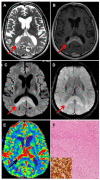Reassessing the Role of Brain Tumor Biopsy in the Era of Advanced Surgical, Molecular, and Imaging Techniques-A Single-Center Experience with Long-Term Follow-Up
- PMID: 34575685
- PMCID: PMC8472374
- DOI: 10.3390/jpm11090909
Reassessing the Role of Brain Tumor Biopsy in the Era of Advanced Surgical, Molecular, and Imaging Techniques-A Single-Center Experience with Long-Term Follow-Up
Abstract
Brain biopsy is the gold standard in order to establish the diagnosis of unresectable brain tumors. Few studies have investigated the long-term outcomes of biopsy patients. The aim of this single-institution-based study was to assess the concordance between radiological and histopathological diagnoses, and the long-term patient outcome. Ninety-three patients who underwent brain biopsy in the last 5 years were analyzed. We included patients treated with stereotactically guided needle, open, and neuroendoscopic biopsies. Most patients (86%) received needle biopsy. Gliomas and primary brain lymphomas comprised 88.2% of cases. The diagnostic yield was 95.7%. Serious complication and death rates were 3.2% and 2.1%, respectively. The concordance rate between radiological and histological diagnoses was 93%. Notably, the positive predictive value of radiological diagnosis of lymphoma was 100%. Biopsy allowed specific treatment in 72% of cases. Disease-related neurological worsening was the main reason that precluded adjuvant treatment. Adjuvant treatment, in turn, was the strongest prognostic factor, since the median overall survival was 11 months with vs. 2 months without treatment (p = 0.0002). Finally, advanced molecular evaluations can be obtained on glioma biopsy specimens to provide integrated diagnoses and individually tailored treatments. We conclude that, despite the huge advances in imaging techniques, biopsy is required when an adjuvant treatment is recommended, particularly in gliomas.
Keywords: biopsy; follow-up; high-grade glioma; primary brain lymphoma; radiology.
Conflict of interest statement
The authors confirm that there is no conflict of interest with any financial organization regarding the material discussed in this manuscript.
Figures


References
-
- Woodworth G.F., McGirt M.J., Samdani A., Garonzik I., Olivi A., Weingart J.D. Frameless image-guided stereotactic brain biopsy procedure: Diagnostic yield, surgical morbidity.; and comparison with the frame-based technique. J. Neurosurg. 2006;104:233–237. doi: 10.3171/jns.2006.104.2.233. - DOI - PubMed
LinkOut - more resources
Full Text Sources

